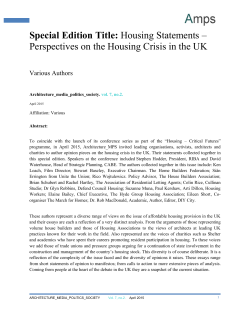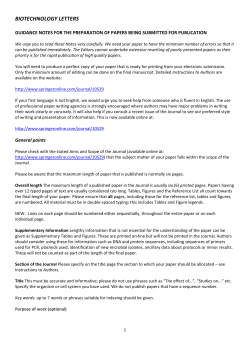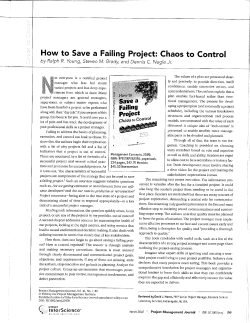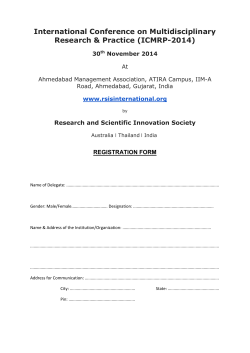
Archaeological Dialogues: notes for authors
Archaeological Dialogues
Notes for Authors
Archaeological Dialogues is an international academic journal of archaeology. It has rigorous and
extensive peer-review and is recognised as one of the top journals in the field. Archaeological
Dialogues is included in the Thomson Reuters Arts and Humanities Citation Index.
Procedures
We publish a mixture of commissioned and unsolicited articles and welcome unsolicited submissions
of interesting and original archaeological work. Manuscripts should be submitted in good English.
Please follow these guidelines closely so that we can direct editorial efforts towards achieving
quality publication. Manuscripts that fail to conform to these guidelines may be returned to the
author for further modification. When submitted to AD manuscripts will be acknowledged on
receipt. They will be evaluated first by the editorial board. If scope, quality and language are
appropriate they will then be sent to two or more anonymous referees. The editorial board will
make a final decision on whether the paper can be accepted, accepted subject to modifications, or
rejected. In all cases the author(s) will be given feedback on their submission. The process of
evaluation may take up to six months. In the case of a discussion article (see below) comments are
then solicited from a range of relevant experts. These are then sent to the author who has the
opportunity to make a written reply to the comments. Before an article goes to print authors will
receive a copy of the galley proofs for checking. On publication, authors will receive a PDF of their
own contribution and a hard copy of the whole issue.
Open Access Policies
Please visit Open Access Publishing at Cambridge for information on our open access policies,
compliance with major finding bodies, and guidelines on depositing your manuscript in an
institutional repository.
Types of contributions
Archaeological dialogues publishes two main types of article: 'discussion articles' and 'articles.' The
former are accompanied by published comments and a reply. Discussion articles are usually longer,
up to 8‐9000 words, whereas articles are typically around 4‐7000 words. Discussion papers usually
take longer to appear in print because of the time required for comments and reply. In addition, the
journal publishes 'provocations’ and ‘reactions’. These are short pieces normally less than 2000
words which take a novel or provocative stance on a particular topic, likely to initiate a lively
dialogue, or which respond to an article previously published in Archaeological dialogues.
Provocations and Reactions can more essay-like in style. They are not subject to full peer review but
are reviewed by the editorial board. Review essays and interviews are usually solicited by the
editorial board, but scholars with suggestions in this direction are encouraged to contact us.
Submission of contributions
Manuscripts can be sent as email attachments to any of the Editors, or to the central e-mail address
dialogues@cambridge.org. Ideally low resolution versions of figures should be submitted at the
same time, but eventually high resolution versions will be required. Hard copies of papers and
figures, if necessary should be sent to: Archaeological Dialogues, c/o Jeremia Pelgrom, Koninklijk
Nederlands Instituut Rome, Via Omero 10/12, 00197 ROMA, ITALY.
Authors are solely responsible not only for the contents of their manuscript, but also for securing
any legal rights or permissions to submitted materials, included copyright protected materials. The
appropriate acknowledgements should be given in figure captions or elsewhere. Manuscripts should
not be submitted to (nor should they have been published in) any other journal or publication.
Sections of the manuscript
The manuscript should include the following sections:
Text: Number all pages. Start with the Author's name(s) followed by the title of the paper;
above the text insert
abstract (circa 150 words)
6 keywords. Keywords will be used by CJO to link to other articles and as online search
terms. The choice of keywords is therefore important: words already included in the title
need not be repeated.
Headings: Use only primary and secondary headings and please do not number them. Use
lowercase letters for both. Use two or three hard returns after the heading to indicate
primary and secondary level headings respectively. Headings should be clearly separated
from the following text.
Acknowledgements: Should be included in a note attached to the title of the paper
Notes: Begin on a separate page; number sequentially; use sparingly
References: Begin on a separate page (see guidelines below)
Figure captions: Begin on a separate page; list figures sequentially (all plates, illustrations,
graphs, tables or other original artwork are numbered as figures)
Biographical note: Include at least the name(s), affiliation(s) and full address(es) of authors,
a note on interests, other relevant information such as fieldwork projects or recent
publications. This should be no longer than 150-200 words (excluding address)
Supplementary material
Authors may submit additional relevant supplementary material which will be considered for
online only publication alongside their article. Authors who wish to submit additional
material electronically are advised to contact the editors to discuss the best way of doing
this.
Comments and reply
Comments for a discussion are normally around 1200-1500 words. We suggest that
formulaic compliments are omitted in order to focus on the discussant's opinion of the
paper. Your comment should be sharp, succinct and thought-provoking. Remember that it is
a comment on an article, not an essay in its own right.
Please supply a title for your comment
Please use primary headings only
Figures
All figures should be referred to in the text (Fig. 2).
Figures should be numbered. Electronically submitted figures should include their number in
the file name; hard copies should be numbered lightly in pencil on the back. All hard-copy
figures should be 'camera-ready', i.e. suitable for quality reproduction. Bear in mind that
figures will usually have to be reduced in size; instructions on the size to which they may be
reduced are therefore welcome. Tables should be used sparingly. Figures supplied
electronically should be sent as .tif files and of high resolution.
Charges apply for all colour figures that appear in the print version of the journal. At the
time of submission, contributors should clearly state whether their figures should appear in
colour in the online version only, or whether they should appear in colour online and in the
print version. There is no charge for including colour figures in the online version of the
journal. If you request colour figures in the printed version, you will be contacted by CCCRightslink who are acting on our behalf to collect Author Charges. Please follow their
instructions in order to avoid any delay in the publication of your article.
Electronic text file
Our preferred format is MS-Word. Please contact the editors in advance if you plan to send
use text in any other format.
Minimise embedded formatting, except for italics. Texts should be unjustified and at least
one-and-a-half spaced. Paragraphs should be indicated by the insertion of a blank line, not
by indentation.
Never use more than one space. Do not insert spaces between initials (A.M.J. Derks, not A.
M. J. Derks). Punctuation should be followed by a single space, but never preceded by one
except when using a dash – which should have a space before and after.
Abbreviations
Limit the use of abbreviations
Do not use abbreviations to denote institutions; write their name in full
In general: A.D. and B.C. (not AD and BC); ca (not ca.); cf. (not cf); ed. (not ed); eds (not eds.);
e.g. (not eg); et al. (not et al); ibid. (not ibid); Ph.D. (not PhD); P.O. Box (not PO Box); pp. (not
pp); 1990s (not 1990's); viz. (not viz). And we prefer C14 method; but 14C (element).
Quotations and quotation marks
Quotations up to four lines should be included in the running text. Quotations exceeding four lines
are to be separated from the text by means of a hard return before and after the quotation. Use
single 'quotation marks', not " (except for quotations within quotations).
Numbers
Spell out numbers one to nine; express all numbers greater than nine with arabic numerals.
Spell out million and billion
Spell out numbers that begin sentences
Spell out numbers used in a general sense ('thousands of sherds')
For dates and time: 40 hours; 30 October 1984; 20th century (but if used as an adjective,
20th-century architecture); 18th Dynasty; 1990s (not 1990's); 1933-34 (not 1933-4)
Measurements
Distance, area, volume, and weight must be expressed in the metric system.
Radiometric dating conventions
Following established convention the authors should use the following abbreviations: B.P. for
uncalibrated dates; Cal. B.P./B.C./A.D. for calibrated dates; B.C. and A.D. for historical dates. B.P. and
B.C. follow the date (1235 B.C.); A.D. precedes the date (A.D. 476; but the fifth century A.D.). Please
give laboratory abbreviations and number if the radiocarbon age is published for the first time.
Identify, and if necessary define the calibration standard and correction factor used.
Spelling
British, not American: artefact, not artifact, medieval, not mediaeval, but follow original in a
direct quote;
-ize spellings when permitted if preferred, but watch for words like advertise, precise, revise
where there is no -ize option;
Use of capitals and lower case letters
In general: Keep capitalization to a minimum. You will generally find that when the definite
article (the) precedes the noun you use upper case and when the same noun is used adjectivally,
lower case is correct (the Government, government policy, the Orient, oriental, the West,
western, the Army, the British army).
additional examples: to the North, the north-west region, southern Europe, north-east England,
Concerning archaeological jargon: use upper case for specific, recognised, historical and person
based names and lower case for general, common or mundane things. Proper names of periods
of time or natural phenomena, historical eras and events take a capital if they have a definite
archaeological significance as shown by a consistent usage (Paleozoic era, Carboniferous,
Tertiary, (New) Stone Age, Bronze Age, Beaker Folk etc.). Cardinal points and other adjectives
are lower case except when they form part of a recognised geographical region, period of time,
institution or movement (Low Countries, Old World, House of Commons, Middle English, First
World War).
Some examples:
· Latin, French, etc. (substantive),
· Dutch, European, Romano-British, Near Eastern etc. (adjective),
· Quarternary, Palaeolithic, Mesolithic, Iron Age, Beaker etc. (substantive); use of early/Early,
late/Late etc. depends on (in-)definite archaeological significance as shown by (in-)consistent
usage; the modifying word is in lower case: Upper Paleolithic period, Anasazi culture, etc.),
· bronze age site, early bronze age sword etc. (adjective; however Palaeolithic era),
· the Magdalenian, the Natufian, etc. (substantive),
· magdalenian, natufian, etc. (adjective),
· bandceramic pottery, etc. (adjective),
· New Archaeology,
· the Renaissance, the Dark Ages, the Mediterranean, (substantive, specific usage; however: the
renaissance of ..., mediterranean climate, general usage),
· names of rivers, mountains, oceans: these names are capitalised along with the generic name
(lake , mountain, river, valley etc.) when they are used as part of a name (River Thames, Lake
Michigan, Mount Cook etc.). When a generic name is used descriptively rather than as part of a
name it is lowercased (the valley of the Mississippi, the Thames river, the Mississippi River valley
etc.)
· title of book: a title of a (non-German) book mentioned in the text should be written with a
capital letter for the initial letter of title and for the initial letter of (proper) names.
Italics
Italics are used to mark all non-English words and concepts: Bandkeramik (bandceramic, no italics
used), Annales, limes. Abbreviations of Latin phrases however (ibid. etc.) should not be italicised.
Use italics to mark titles of books and articles which are cited within the text in full.
Some additions
Never use the ampersand (&): please write out the word ‘and’.
Words in non-Roman alphabets should be transliterated if possible.
Notes
The use of notes must be limited as far as possible. Essential notes should follow the text (endnotes).
References
within the text: (Myhre 1990) or (Myhre 1990, 12-121) or (Myhre 1990, 21-24) or (cf. Myhre
1990, 34-36) or `advocated by Myhre (1990; 1996)'. Use `and' between two authors: (Roymans
and Theuws 1990) or (Besteman, Bos and Heidinga 1990). Use `et al.' for more than three
authors (Kolen et al. 1995). (Do not use `et al.' in the references however.) Use a, b, c etc. for
titles published within one year (Waterbolk 1982a; 1982b). If used within parentheses, the
above citations do not change parentheses to square brackets: (see the innovative study
recently produced by Van der Veer (1994))
within References follow the conventions evident in published issues
some examples:
· Bakker, J.A., 1992: The Dutch hunebedden, Ann Arbor.
· Renfrew, C., M.J. Rowlands and S.A. Segraves (eds), 1982: Theory and explanation in
archaeology, London.
· Webmoore, T., and C. Witmore, 2008: Things are us! A commentary on human/things relations
under the banner of a ‘social’ archaeology, Norwegian Archaeological Review 41, 53-70.
Hermann, F.R., and A. Jockenhövel, 1975: Bronzezeitliche Grabhügel mit Pfostenringen bei
Edelsberg, Kreis Limburg-Weilburg, Fundberichte aus Hessen 15, 87-127.
· Kristiansen, K., 1984: Ideology and material culture. An archaeological perspective, in M.
Spriggs (ed.), Marxist perspectives in archaeology, Cambridge, 72-100.
· Ingold, T., 1992: Culture and the perception of the environment, in E. Croll and D. Parkin (eds),
Bush base, forest farm. Culture, environment and development, London, 39-56.
· Pollard, J., 2004: A ‘movement of becoming’. Realms of existence in the early Neolithic of
southern Britain, in A. Chadwick (ed.), Stories from the landscape. Archaeologies of inhabitation,
Oxford (British Archaeological Reports, International Series 1238), 55-70.
in non-German titles, use a capital letter only for the initial letter of the title and for the initial
word of (proper) names.
title and subtitle of a book or article are separated by a full stop (not :) and a space.
Last updated: 8th April 2015
© Copyright 2025





















